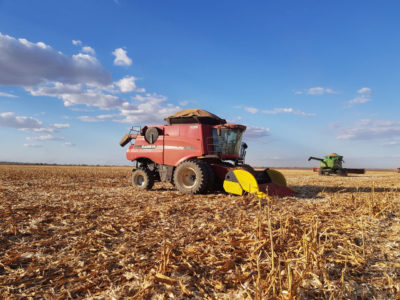15 Year Survey Watches As Amazon Basin Tips From Carbon Sink To Source; 1/3 Of Xingu Basin Now Gone
 The boundary between Tanguro Farm and the Amazon rainforest in Mato Grosso, Brazil. Courtesy of Chris Linder
The boundary between Tanguro Farm and the Amazon rainforest in Mato Grosso, Brazil. Courtesy of Chris Linder
EDIT
Thanks to a deal struck at a chance meeting between Woods Hole researcher Dan Nepstad and the company’s CEO and then-state governor Blairo Maggi, American researchers and colleagues from the Amazon Environmental Research Institute (IPAM) have since 2004 been monitoring the forest and researching how the climate is changing in and around it.
And following the widespread fires set this year on the fringes of the Amazon – breaking a run of 15 years during which deforestation had been dramatically reduced – places such as this are on the front line as the Amazon faces its most fundamental crisis, with temperatures rising, dry seasons lengthening, and rainforest trees being replaced by savanna species.
More than a third of the Xingu Basin, a region bigger than New York State, is now deforested. Scraps of tree cover are all that remain outside the still densely forested Xingu indigenous reserve at its heart. I am shown around by Coe and Divino Silvério, the son of a local farmer. whose research work on the station has garnered him a doctorate and a string of highly regarded scientific papers. “We have over a decade of data here. Nowhere else in the tropics has that,” says Coe.
 Tanguro is one of the largest farms in Mato Grosso. In total, more than a third of the Xingu Basin has been deforested, much of it for growing soybeans. Courtesy of Michael Coe
Tanguro is one of the largest farms in Mato Grosso. In total, more than a third of the Xingu Basin has been deforested, much of it for growing soybeans. Courtesy of Michael Coe
What they are seeing is alarming. Deforestation is dramatically raising local temperatures. The air over the farm is on average 5 degrees Celsius hotter than in the forested reserve over the fence: 34 degrees C, rather than 29 degrees C. The difference rises to a staggering 10 degrees at the end of the dry season, says Coe. And the dry season is lengthening. Across the Xingu Basin and through the southern Amazon region known as the “arc of deforestation,” it lasts almost four weeks longer than half a century ago.
Why these huge changes? The answers lie not in global climate change but in the impact of deforestation, says Coe. In the old days, the trees of the rainforest acted as water pumps, recycling most of the rainwater, which they pumped from underground and released into the atmosphere from the pores in their leaves, a process known as transpiration. Transpiration requires large amounts of energy, taken from solar radiation. “Every square meter of forest removes the heat equivalent of about two 60-watt [light] bulbs burning 14 hours per day,” Coe calculated in one study. So it cools the air of intact forest. But take away the forest, and the air is instantly much hotter.
EDIT
https://e360.yale.edu/features/amazon-watch-what-happens-when-the-forest-disappears

